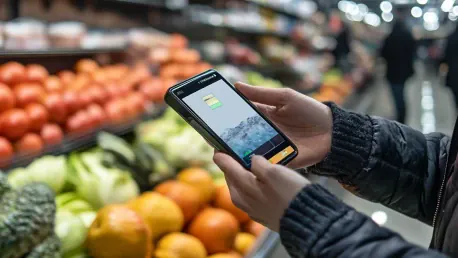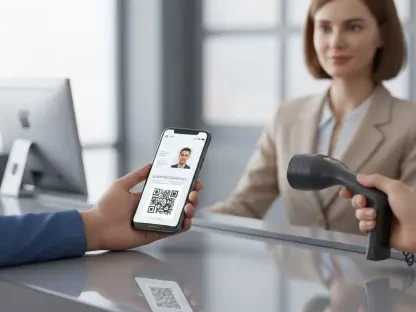Mobile payments have revolutionized the way we conduct transactions, offering unprecedented convenience, speed, and security. As consumers increasingly turn to digital solutions, retailers must adapt to these evolving preferences to stay competitive. This article explores the various facets of mobile payments and their transformative impact on retail transactions.
The Rise of Mobile Payments
Definition and Mechanics
Mobile payments refer to digital transactions made through smart devices such as smartphones, tablets, or smartwatches. These payments leverage encryption technology to ensure secure and convenient transactions. A key component of mobile payments is the mobile wallet, which digitally stores card details, allowing users to make payments without a physical wallet. This method enhances security through encryption and tokenization, making it a preferred choice for many consumers.
The adoption of mobile payments is driven by the need for simpler, faster, and safer transactions. The use of encryption and tokenization protects sensitive information and minimizes the risk of fraud, contributing significantly to consumer confidence. This increased convenience allows users to avoid the hassle of carrying physical cards, bringing about a seamless experience both in-person and online.
Operational Principles
Mobile payments primarily rely on near-field communication (NFC) technology, which facilitates data transfer between devices in close proximity. This technology enhances security by using radio wave identification, ensuring that transactions are both quick and secure. The integration of NFC technology into mobile payment systems has significantly contributed to their widespread adoption.
In addition to NFC, many mobile payment systems also employ biometric verification methods, such as fingerprint scanning or facial recognition, further enhancing the security of each transaction. With these advanced verification techniques, mobile payments are not only efficient but also minimize the threat of unauthorized access. This technological synergy between convenience and security is part of what makes mobile payments increasingly popular among a tech-savvy consumer base.
Benefits of Mobile Payments
Convenience and Speed
One of the most significant advantages of mobile payments is the convenience they offer. By eliminating the need for physical money or cards, mobile payments provide a more streamlined and less cumbersome transaction method. This convenience extends to both online and in-store purchases, making the shopping experience more enjoyable for consumers. Additionally, mobile payments ensure rapid transaction processing, which is beneficial for both retailers and customers.
The speed of mobile payments reduces wait times at checkout lanes and enables quicker processing of online orders, thereby enhancing overall customer satisfaction. With fast transaction times, retailers can serve more customers within shorter periods, potentially increasing sales volume. Additionally, the capability to integrate loyalty programs and rewards into mobile payment systems keeps customers engaged and encourages repeat business.
Enhanced Security
Security is a paramount concern for both consumers and retailers. Mobile payments address this concern by introducing multiple layers of security, such as individual security codes and tokenization. These measures help prevent fraud and protect sensitive information, making mobile payments a safer alternative to traditional payment methods. The use of encryption technology further bolsters the security of mobile transactions.
The advanced security features associated with mobile payments also instill greater buyer confidence, which is crucial in an age where data breaches and fraud are common. Tokenization replaces sensitive information with encrypted codes, making it significantly harder for malicious entities to steal actual payment details. This robust security framework ensures that both consumers and retailers can engage in transactions with peace of mind.
Types of Mobile Payments
NFC Mobile Payments
NFC mobile payments utilize near-field communication technology to enable contactless transactions. Services like Apple Pay and Google Pay are prime examples of NFC mobile payments. These systems allow users to make secure, rapid transactions by simply tapping their devices on a compatible terminal. The ease and security of NFC mobile payments have made them increasingly popular among consumers.
The simplicity of NFC payments, which require just a tap of the device, significantly enhances customer convenience while ensuring high levels of security. These payments are particularly beneficial in fast-paced retail environments where speed is crucial. Retailers that accept NFC payments can offer a more efficient checkout process, reducing lines and wait times, thereby enhancing the overall shopping experience.
Browser-Based Mobile Payments
Browser-based mobile payments facilitate card-not-present (CNP) transactions through an online checkout interface. This type of payment is particularly useful for online shopping, where users can enter their payment information at checkout. Browser-based mobile payments offer a convenient and secure way to complete online purchases, catering to the growing trend of e-commerce.
The rise of e-commerce has necessitated efficient and secure online payment solutions, and browser-based mobile payments fit this need perfectly. These payments often integrate with various security protocols such as Secure Sockets Layer (SSL) encryption to protect data during transmission. Given the escalating trend towards online shopping, especially in the wake of global events that restrict physical retail operations, this payment method has become a mainstay in digital commerce.
In-App Mobile Payments
In-app mobile payments enable consumers to complete purchases within an app, enhancing the user experience and driving higher conversion rates. By allowing users to make transactions without leaving the application, in-app mobile payments streamline the purchasing process and reduce friction. This method is especially beneficial for businesses with dedicated mobile apps, as it encourages repeat purchases and customer loyalty.
The seamless integration of payment gateways within mobile apps helps businesses offer a smooth and uninterrupted user experience. This not only improves customer satisfaction but also boosts sales by reducing cart abandonment rates. Additionally, in-app payments can be tailored to incorporate personalized offers and promotions, further enticing users to make purchases and fostering a stronger customer-business relationship.
Peer-to-Peer Mobile Payments
Peer-to-peer (P2P) mobile payments support money transfers between individuals via platforms like Venmo or PayPal. These payments offer a convenient and immediate way to transfer funds, making them ideal for personal transactions. P2P mobile payments have gained popularity due to their ease of use and the ability to send money quickly and securely.
The ability to transfer money effortlessly among friends, family, and acquaintances without the need for cash or checks has revolutionized personal financial interactions. P2P payment platforms have also expanded their services to include features like bill splitting, which simplifies shared financial responsibilities. This functionality not only improves user convenience but also encourages a greater degree of digital engagement in personal financial management.
Implementing Mobile Payments in Retail
Integration with POS Systems
Adopting mobile payment methods through a robust Point of Sale (POS) system provides numerous benefits for retailers. A sophisticated POS system can facilitate both online and in-person transactions seamlessly, ensuring a smooth checkout experience for customers. Additionally, these systems can track key sales data, helping retailers monitor sales performance and manage inventory more efficiently.
Integrating mobile payments with modern POS systems allows retailers to offer varied payment options, catering to a wider range of consumer preferences. This flexibility can be a significant competitive advantage. Furthermore, the data analytics capabilities of advanced POS systems provide valuable insights into consumer behavior, enabling retailers to make informed decisions about inventory management, marketing strategies, and product placement. This comprehensive approach ensures that retailers can optimize their operations and enhance customer satisfaction.
Enhancing Customer Experience
Implementing mobile payments can significantly enhance the customer experience. By offering a variety of payment options, retailers can cater to diverse consumer preferences and improve overall satisfaction. The speed and convenience of mobile payments also contribute to a more enjoyable shopping experience, encouraging repeat business and fostering customer loyalty.
Mobile payments also allow retailers to integrate loyalty programs and personalized offers, making the shopping experience more engaging and rewarding for customers. The ability to quickly access rewards and discounts during checkout can significantly enhance customer satisfaction and loyalty. Moreover, the convenience of mobile payments often results in faster checkouts and reduced waiting times, which are crucial factors in providing a positive retail experience.
The Future of Mobile Payments
Technological Advancements
The future of mobile payments looks promising, with ongoing technological advancements poised to further enhance their capabilities. Innovations such as Apple’s tap-to-pay feature are set to offer even higher levels of security and convenience. As technology continues to evolve, mobile payments will likely become even more integral to the retail landscape.
Emerging technologies, such as blockchain and digital currencies, also hold potential for further transforming mobile payments by providing even more secure and transparent transaction mechanisms. As these technologies become more mainstream, they will likely be integrated into existing mobile payment systems, offering enhanced functionality and security. Retailers that stay ahead of these technological trends will be better positioned to capitalize on new opportunities and remain competitive in a rapidly evolving market.
Consumer Adoption Trends
Data suggests a substantial increase in digital wallet usage, indicating a broader acceptance and reliance on mobile payment options. As consumers become more accustomed to digital transactions, the demand for mobile payment solutions will continue to grow. Retailers who embrace these trends and integrate mobile payments into their operations will be better positioned to meet consumer expectations and drive sales.
The trend towards digital payments is expected to accelerate as younger, tech-savvy generations enter the consumer market. Their preference for fast, convenient, and secure payment methods will drive further innovations and adoption in the mobile payments sector. For retailers, this means continuously evolving their payment systems to meet the changing expectations of their customers.
Conclusion
Mobile payments have fundamentally transformed the way we conduct financial transactions, bringing a new level of convenience, speed, and security. As consumers increasingly favor digital solutions for their purchasing needs, it’s imperative for retailers to adapt to these changing preferences to remain competitive in the marketplace. This article delves into the numerous aspects of mobile payments and examines their significant impact on retail transactions.
Mobile payments offer the ease of making purchases with just a smartphone, eliminating the need for carrying physical cash or cards. This shift not only speeds up the checkout process but also enhances overall customer satisfaction. Advanced security features such as encryption and biometric authentication further bolster confidence among users, making mobile payments a secure option.
Retailers that embrace mobile payment technologies can streamline their operations, reduce transaction times, and improve the customer experience. Moreover, they can benefit from the data insights generated by digital transactions, enabling them to better understand customer behavior and tailor their marketing strategies accordingly.
In today’s fast-paced retail environment, staying ahead of digital trends is crucial. Retailers who incorporate mobile payment options are likely to see increased customer loyalty and higher sales. Overall, the rise of mobile payments is a game-changer in the retail industry, setting a new standard for how transactions are conducted.









